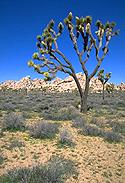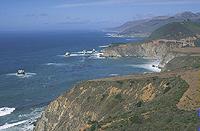
Global
Climate Change: Impacts
Climate
affects everything from the flora and fauna which inhabit
a region to the heating and cooling requirements of homes and businesses. When climate
begins to change, all living things must adapt their lifestyles in order
to survive. Global climate change could impact agriculture,
ecosystems, forests, sea level, regional weather, human health, and human
economics.
Agriculture:
Changes in temperature
and precipitation patterns may lead to changes in the length of growing seasons
and/or the rates of photosynthesis by plants. Such changes could lead to
decrease in crop yield.
A major cause of global climate change--increased concentrations of atmospheric carbon dioxide (CO2)--may actually cause some plants to grow better.
 Ecosystems:
Ecosystems:
Biomes,
which are closely related to the temperature and precipitation of a
region, may actually change. For example, some forest regions could
warm up, dry out, and become deserts. Warmer temperatures in
northern latitudes may cause alpine forests to disappear as temperate
forests migrate northward into these areas that had previously been too
cold for them to survive. Photo:
Joshua Tree National Park in the Mojave Desert in the Southwestern United
States. Photo courtesy of Phil Greenspun.
Since ecosystem evolution is generally a slow process, some elements of an ecosystem might have problems adapting to rapid climate change and may not survive. For example, increased ocean temperatures may cause a decline in fisheries.
Sea Level:
If increased temperatures
cause the polar ice sheets to melt, then sea level will rise as a result
of the increased amount of water flowing into the sea.
Photo: California coast. Photo courtesy of Phil Greenspun.
If the sea level rises, there will be more coastal flooding
Water Availability:
Increases in
temperature and a decrease in precipitation may result in increased
pressure from people on the ground water supply. People need water for
personal use, industrial usage, and agriculture.
Weather:
A warmer atmosphere
may create more storms and more extreme weather events due to the increased
amount of energy present in the system
Human Economics:
Decreased crop,
livestock, and fishery yields, due to increased temperatures and/or decreased
precipitation, may lead to economic loss for producers
Decreased crop, livestock, and fishery yields, due to increased temperatures and/or decreased precipitation, may lead to higher market prices for consumers
For more information, see the EPA's Impacts of Global Warming site. Or check out the EPA's Global Warming Impacts State-by-State, where you can see possible effects of climate change on each U.S. state.
Overview
..|..
Human Influences ..|..
Impacts
Glossary ..|..
Related
Links ..|..
References
|..
PBL
Model
Home ..|.. Teacher Pages ..|.. Modules & Activities
HTML code by Chris
Kreger
Maintained by ETE
Team
Last updated November 10, 2004
Some images © 2004 www.clipart.com
Privacy Statement and Copyright © 1997-2004 by Wheeling Jesuit University/NASA-supported Classroom of the Future. All rights reserved.
Center for Educational Technologies, Circuit Board/Apple graphic logo, and COTF Classroom of the Future logo are registered trademarks of Wheeling Jesuit University.

